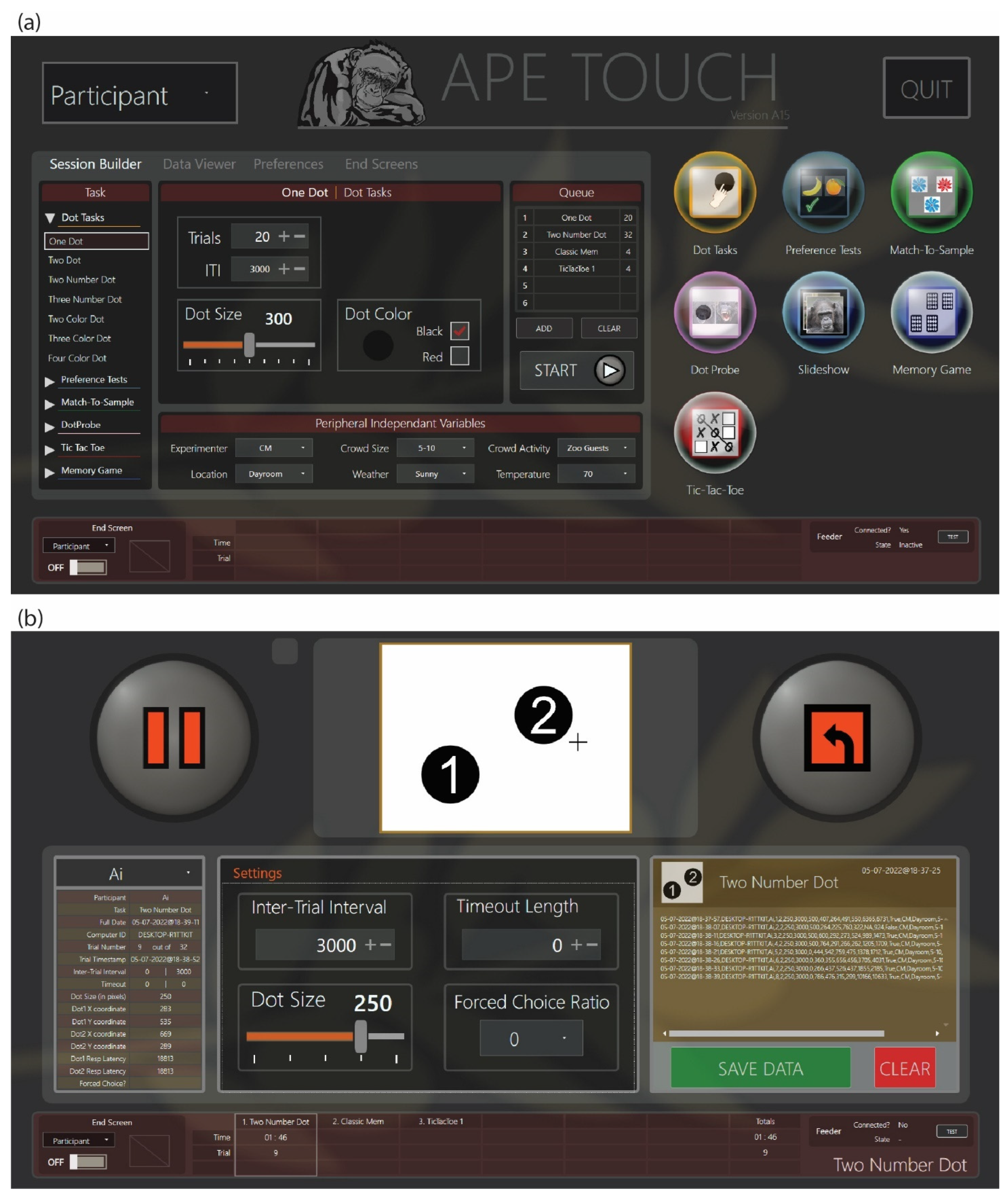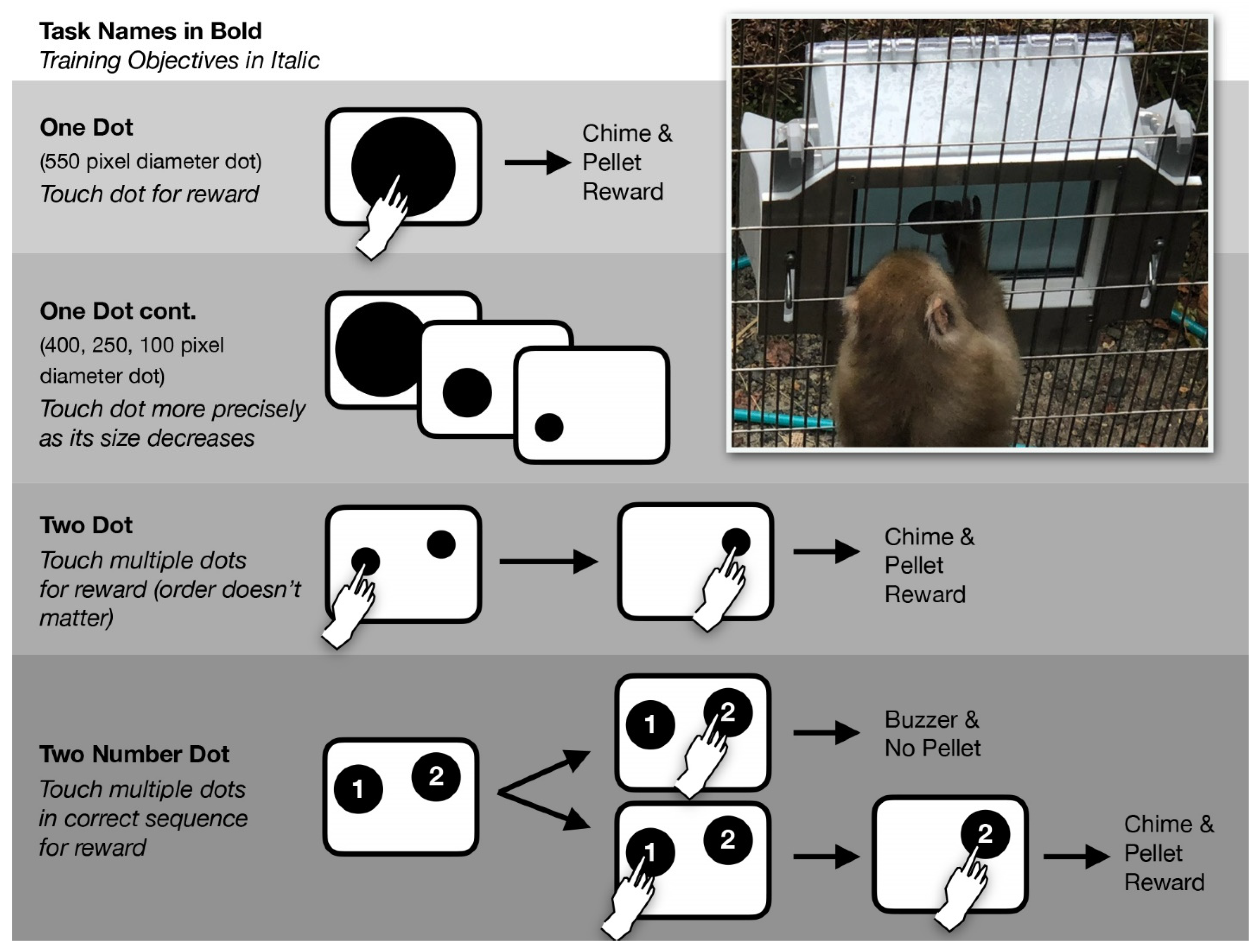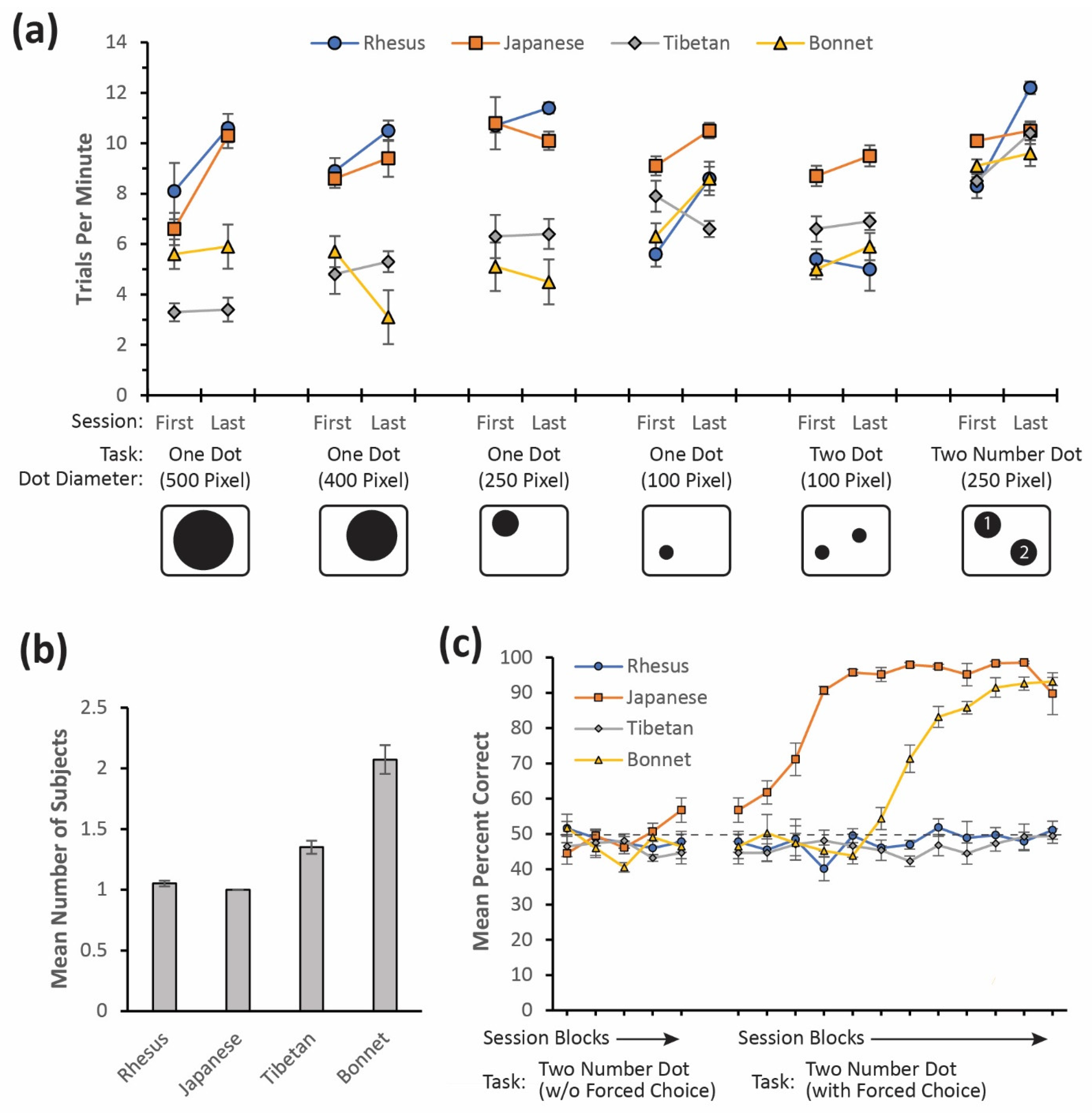Apex and ApeTouch: Development of a Portable Touchscreen System and Software for Primates at Zoos
Abstract
Simple Summary
Abstract
1. Introduction
2. Materials and Methods
2.1. Apex Apparatus
2.2. ApeTouch Software
2.3. Subjects
2.4. Experimental Procedure
3. Results
3.1. Engagement
3.2. Performance
4. Discussion
5. Conclusions
Supplementary Materials
Author Contributions
Funding
Institutional Review Board Statement
Informed Consent Statement
Data Availability Statement
Acknowledgments
Conflicts of Interest
References
- Ford, C.A.; Bellward, L.; Phillips, C.J.C.; Descovich, K. Use of Interactive Technology in Captive Great Ape Management. J. Zool. Bot. Gard. 2021, 2, 21. [Google Scholar] [CrossRef]
- Hopper, L.M. Primatology in Zoos: Studying Behavior, Cognition, and Welfare. Am. J. Primatol. 2022, e23385. [Google Scholar] [CrossRef] [PubMed]
- McEwen, E.S.; Warren, E.; Tenpas, S.; Jones, B.; Durdevic, K.; Rapport Munro, E.; Call, J. Primate Cognition in Zoos: Reviewing the Impact of Zoo-Based Research over 15 Years. Am. J. Primatol. 2022, e23369. [Google Scholar] [CrossRef]
- Egelkamp, C.L.; Ross, S.R. A Review of Zoo-Based Cognitive Research Using Touchscreen Interfaces. Zoo Biol. 2019, 38, 220–235. [Google Scholar] [CrossRef]
- Elsmore, T.F.; Parkinson, J.K.; Mellgren, R.L. Video touch-screen stimulus-response surface for use with primates. Bull. Psychon. Soc. 1989, 27, 60–63. [Google Scholar] [CrossRef][Green Version]
- Martin, C.F.; Adachi, I. 8 Automated Methods and the Technological Context of Chimpanzee Research. In Chimpanzees in Context; Hopper, L.M., Ross, S.R., Eds.; University of Chicago Press: Chicago, IL, USA, 2020; pp. 189–207. [Google Scholar]
- Matsuzawa, T. The Ai Project: Historical and Ecological Contexts. Anim. Cogn. 2003, 6, 199–211. [Google Scholar] [CrossRef] [PubMed]
- Shumaker, R.W. The History and Status of Cognitive Research with Great Apes in the United States. Jpn. J. Anim. Psychol. 2018, 68, 105–119. [Google Scholar] [CrossRef]
- Egelkamp, C.; Hopper, L.; Cronin, K.; Jacobson, S.; Ross, S. Using Touchscreens to Explore the Welfare and Cognition of Zoo-Housed Primates. PeerJ Prepr. 2016, 4, e2312v1. [Google Scholar] [CrossRef]
- Tanaka, M. Comparative Cognition in Zoo Animals. Jpn. J. Anim. Psychol. 2016, 66, 53–57. [Google Scholar] [CrossRef][Green Version]
- Brady, R.J.; Mickelberg, J.M.; Hampton, R.R. Greater Dependence on Working Memory and Restricted Familiarity in Orangutans Compared with Rhesus Monkeys. Learn. Mem. 2021, 28, 260–269. [Google Scholar] [CrossRef]
- Martin, C.F.; Shumaker, R.W. Computer Tasks for Great Apes Promote Functional Naturalism in a Zoo Setting. In Proceedings of the Fifth International Conference on Animal-Computer Interaction (ACI ‘18). Association for Computing Machinery, New York, NY, USA, 4–6 December 2018; Article 7. pp. 1–5. [Google Scholar] [CrossRef]
- Allritz, M.; Call, J.; Borkenau, P. How Chimpanzees (Pan troglodytes) Perform in a Modified Emotional Stroop Task. Anim. Cogn. 2016, 19, 435–449. [Google Scholar] [CrossRef] [PubMed]
- Altschul, D.M.; Wallace, E.K.; Sonnweber, R.; Tomonaga, M.; Weiss, A. Chimpanzee Intellect: Personality, Performance and Motivation with Touchscreen Tasks. R. Soc. Open Sci. 2017, 4, 170169. [Google Scholar] [CrossRef] [PubMed]
- Déaux, E.C.; Baumeyer, A.; Zuberbühler, K. Food Calls Enhance Visual Discrimination Learning in Chimpanzees (Pan troglodytes verus). J. Comp. Psychol. 2021, 135, 420–429. [Google Scholar] [CrossRef] [PubMed]
- Vonk, J.; McGuire, M.; Leete, J. Testing for the “Blues”: Using the Modified Emotional Stroop Task to Assess the Emotional Response of Gorillas. Animals 2022, 12, 1188. [Google Scholar] [CrossRef] [PubMed]
- Fernandez, E.J.; Timberlake, W. Mutual Benefits of Research Collaborations between Zoos and Academic Institutions. Zoo Biol. 2008, 27, 470–487. [Google Scholar] [CrossRef] [PubMed]
- Jacobson, S.L.; Kwiatt, A.C.; Ross, S.R.; Cronin, K.A. The Effects of Cognitive Testing on the Welfare of Zoo-Housed Japanese Macaques (Macaca fuscata). Appl. Anim. Behav. Sci. 2019, 212, 90–97. [Google Scholar] [CrossRef]
- Whitehouse, J.; Waller, B.M.; Chanvin, M.; Wallace, E.K.; Schel, A.M.; Peirce, K.; Mitchell, H.; Macri, A.; Slocombe, K. Evaluation of Public Engagement Activities to Promote Science in a Zoo Environment. PLoS ONE 2014, 9, e113395. [Google Scholar] [CrossRef]
- Clark, F. Cognitive Enrichment and Welfare: Current Approaches and Future Directions. Anim. Behav. Cogn. 2017, 4, 52–71. [Google Scholar] [CrossRef]
- Morimura, N. Cognitive Enrichment in Chimpanzees: An Approach of Welfare Entailing an Animal’s Entire Resources. In Cognitive Development in Chimpanzees; Matsuzawa, T., Tomonaga, M., Tanaka, M., Eds.; Springer: Tokyo, Japan, 2006; pp. 368–391. [Google Scholar]
- Coe, J.; Hoy, J. Choice, Control and Computers: Empowering Wildlife in Human Care. Multimodal Technol. Interact. 2020, 4, 92. [Google Scholar] [CrossRef]
- Markowitz, H. Behavioral Enrichment in the Zoo; Van Nostrand Reinhold: New York, NY, USA, 1982. [Google Scholar]
- Mancini, C. Animal-Computer Interaction: A Manifesto. Interactions 2011, 18, 69–73. [Google Scholar] [CrossRef]
- Yamanashi, Y.; Hitoosa, K.; Yoshida, N.; Kano, F.; Ikkatai, Y.; Sakamoto, H. Do Chimpanzees Enjoy a Virtual Forest? A Pilot Investigation of the Use of Interactive Art as a Form of Environmental Enrichment for Zoo-Housed Chimpanzees. Am. J. Primatol. 2022, e23343. [Google Scholar] [CrossRef]
- Carter, M.; Sherwen, S.; Webber, S. An Evaluation of Interactive Projections as Digital Enrichment for Orangutans. Zoo Biol. 2021, 40, 107–114. [Google Scholar] [CrossRef] [PubMed]
- Scheer, B.; Renteria, F.; Kunda, M. Technology-Based Cognitive Enrichment for Animals in Zoos: A Case Study and Lessons Learned. In Proceedings of the CogSci, Montreal, QC, Canada, 24–27 July 2019; pp. 2741–2747. [Google Scholar]
- Hirskyj-Douglas, I.; Kankaanpää, V. Article Exploring How White-Faced Sakis Control Digital Visual Enrichment Systems. Animals 2021, 11, 557. [Google Scholar] [CrossRef] [PubMed]
- Hirskyj-Douglas, I.; Webber, S. Reflecting on Methods in Animal Computer Interaction: Novelty Effect and Habituation. In Proceedings of the Eighth International Conference on Animal-Computer Interaction (ACI’21), Bloomington, IN, USA, 8–11 November 2021. [Google Scholar] [CrossRef]
- Huskisson, S.M.; Jacobson, S.L.; Egelkamp, C.L.; Ross, S.R.; Hopper, L.M. Using a Touchscreen Paradigm to Evaluate Food Preferences and Response to Novel Photographic Stimuli of Food in Three Primate Species (Gorilla gorilla gorilla, Pan troglodytes, and Macaca fuscata). Int. J. Primatol. 2020, 41, 5–23. [Google Scholar] [CrossRef]
- Sousa, C.; Matsuzawa, T. The Use of Tokens as Rewards and Tools by Chimpanzees (Pan troglodytes). Anim. Cogn. 2001, 4, 213–221. [Google Scholar] [CrossRef]
- Truax, J.; Vonk, J. Silence Is Golden: Auditory Preferences in Zoo-Housed Gorillas. J. Appl. Anim. Welf. Sci. 2021, 1–16. [Google Scholar] [CrossRef]
- Ritvo, S.E.; MacDonald, S.E. Music as Enrichment for Sumatran Orangutans (Pongo abelii). J. Zoo Aquar. Res. 2016, 4, 156–163. [Google Scholar]
- Clegg, I.L.K. Cognitive Bias in Zoo Animals: An Optimistic Outlook for Welfare Assessment. Animals 2018, 8, 104. [Google Scholar] [CrossRef]
- Cronin, K.A.; Bethell, E.J.; Jacobson, S.L.; Egelkamp, C.; Hopper, L.M. Evaluating Mood Changes in Response to Anthropogenic Noise with a Response-Slowing Task in Three Species of Zoo-Housed Primates. Anim. Behav. Cogn. 2018, 5, 209–221. [Google Scholar] [CrossRef]
- Hopper, L.M.; Allritz, M.; Egelkamp, C.L.; Huskisson, S.M.; Jacobson, S.L.; Leinwand, J.G.; Ross, S.R. A Comparative Perspective on Three Primate Species’ Responses to a Pictorial Emotional Stroop Task. Animals 2021, 11, 588. [Google Scholar] [CrossRef]
- McGuire, M.C.; Vonk, J.; Johnson-Ulrich, Z. Ambiguous Results When Using the Ambiguous-Cue Paradigm to Assess Learning and Cognitive Bias in Gorillas and a Black Bear. Behav. Sci. 2017, 7, 51. [Google Scholar] [CrossRef] [PubMed]
- Leeds, A.; Lukas, K.E. Monitoring the Social Behavior of a Bachelor Mandrill (Mandrillus sphinx) Dyad Participating in Touchscreen-Mediated Cognitive Testing. Zoo Biol. 2019, 38, 397–402. [Google Scholar] [CrossRef]
- Hayashi, M.; Sakuraba, Y.; Watanabe, S.; Kaneko, A.; Matsuzawa, T. Behavioral Recovery from Tetraparesis in a Captive Chimpanzee. Primates 2013, 54, 237–243. [Google Scholar] [CrossRef] [PubMed]
- Sakuraba, Y.; Tomonaga, M.; Hayashi, M. A New Method of Walking Rehabilitation Using Cognitive Tasks in an Adult Chimpanzee (Pan troglodytes) with a Disability: A Case Study. Primates 2016, 57, 403–412. [Google Scholar] [CrossRef] [PubMed]
- Martin, C.F.; Biro, D.; Matsuzawa, T. The Arena System: A Novel Shared Touch-Panel Apparatus for the Study of Chimpanzee Social Interaction and Cognition. Behav. Res. Methods 2014, 46, 611–618. [Google Scholar] [CrossRef]
- Ross, S.R. Sequential List-Learning by an Adolescent Lowland Gorilla (Gorilla gorilla gorilla) Using an Infrared Touchframe Apparatus. Interact. Stud. 2009, 10, 115–129. [Google Scholar] [CrossRef]
- Kawai, N.; Matsuzawa, T. Numerical Memory Span in a Chimpanzee. Nature 2000, 403, 39–40. [Google Scholar] [CrossRef]
- Fagot, J.; Paleressompoulle, D. Automatic Testing of Cognitive Performance in Baboons Maintained in Social Groups. Behav. Res. Methods 2009, 41, 396–404. [Google Scholar] [CrossRef]
- Hopper, L.M.; Egelkamp, C.L.; Fidino, M.; Ross, S.R. An Assessment of Touchscreens for Testing Primate Food Preferences and Valuations. Behav. Res. Methods 2018, 51, 639–650. [Google Scholar] [CrossRef]
- Perdue, B.M.; Beran, M.J.; Washburn, D.A. A Computerized Testing System for Primates: Cognition, Welfare, and the Rumbaughx. Behav. Processes 2018, 156, 37–50. [Google Scholar] [CrossRef]
- Fizet, J.; Rimele, A.; Pebayle, T.; Cassel, J.C.; Kelche, C.; Meunier, H. An Autonomous, Automated and Mobile Device to Concurrently Assess Several Cognitive Functions in Group-Living Non-Human Primates. Neurobiol. Learn. Mem. 2017, 145, 45–58. [Google Scholar] [CrossRef] [PubMed]
- Butler, J.L.; Kennerley, S.W. Mymou: A Low-Cost, Wireless Touchscreen System for Automated Training of Nonhuman Primates. Behav. Res. Methods 2019, 51, 2559–2572. [Google Scholar] [CrossRef]
- Calapai, A.; Berger, M.; Niessing, M.; Heisig, K.; Brockhausen, R.; Treue, S.; Gail, A. A Cage-Based Training, Cognitive Testing and Enrichment System Optimized for Rhesus Macaques in Neuroscience Research. Behav. Res. Methods 2017, 49, 35–45. [Google Scholar] [CrossRef] [PubMed]
- Sacchetti, S.; Ceccarelli, F.; Ferrucci, L.; Benozzo, D.; Brunamonti, E.; Nougaret, S.; Genovesio, A. Macaque Monkeys Learn and Perform a Non-Match-to-Goal Task Using an Automated Home Cage Training Procedure. Sci. Rep. 2021, 11, 2700. [Google Scholar] [CrossRef] [PubMed]
- Womelsdorf, T.; Thomas, C.; Neumann, A.; Watson, M.R.; Banaie Boroujeni, K.; Hassani, S.A.; Parker, J.; Hoffman, K.L. A Kiosk Station for the Assessment of Multiple Cognitive Domains and Cognitive Enrichment of Monkeys. Front. Behav. Neurosci. 2021, 15, 196. [Google Scholar] [CrossRef]
- Schmitt, V. Implementing Portable Touchscreen Setups to Enhance Cognitive Research and Enrich Zoo-Housed Animals. J. Zoo Aquar. Res. 2018, 7, 50–58. [Google Scholar] [CrossRef]
- Lizarraga, S.; Daadi, E.W.; Roy-Choudhury, G.; Daadi, M.M. Age-Related Cognitive Decline in Baboons: Modeling the Prodromal Phase of Alzheimer’s Disease and Related Dementias. Aging 2020, 12, 10099–10116. [Google Scholar] [CrossRef]
- Egelkamp, C.L.; Jacobson, S.L.; Cronin, K.A.; Wagner, K.E.; Ross, S.R.; Hopper, L.M. A Comparison of Sequential Learning Errors Made by Apes and Monkeys Reveals Individual but Not Species Differences in Learning. Int. J. Comp. Psychol. 2019, 32, 024578f5. [Google Scholar] [CrossRef]
- Huskisson, S.M.; Egelkamp, C.L.; Jacobson, S.L.; Ross, S.R.; Hopper, L.M. Primates’ Food Preferences Predict Their Food Choices Even Under Uncertain Conditions. Anim. Behav. Cogn. 2021, 8, 69–96. [Google Scholar] [CrossRef]
- Huskisson, S.M.; Ross, S.R.; Hopper, L.M. Do Zoo Visitors Induce Attentional Bias Effects in Primates Completing Cognitive Tasks? Anim. Cogn. 2021, 24, 645–653. [Google Scholar] [CrossRef]
- Leinwand, J.G.; Huskisson, S.M.; Egelkamp, C.L.; Hopper, L.M. Within- and between-Species Variation in the Responses of Three Primate Species to a Touchscreen Gambling Task. Learn. Motiv. 2020, 71, 101635. [Google Scholar] [CrossRef]
- Leinwand, J.G.; Fidino, M.; Ross, S.R.; Hopper, L.M. Familiarity Mediates Apes’ Attentional Biases toward Human Faces. Proc. R. Soc. B Biol. Sci. 2022, 289, 20212599. [Google Scholar] [CrossRef] [PubMed]
- Martin, C.F.; Shumaker, R.W. Orangutan strategies for solving a visuospatial memory task. Am. J. Primatol. 2022, e23367. [Google Scholar] [CrossRef] [PubMed]
- Cronin, K.A.; Jacobson, S.L.; Bonnie, K.E.; Hopper, L.M. Studying Primate Cognition in a Social Setting to Improve Validity and Welfare: A Literature Review Highlighting Successful Approaches. PeerJ 2017, 2017, e3649. [Google Scholar] [CrossRef]
- Matsumura, S. The Myth of Despotism and Nepotism: Dominance and Kinship in Matrilineal Societies of Macaques. In Primate Origins of Human Cognition and Behavior; Matsuzawa, T., Ed.; Springer: Tokyo, Japan, 2008. [Google Scholar]
- Muramatsu, A. Comparing Social Style in Zoo-Housed Macaques through an Animal Psychology Approach. Jpn. J. Anim. Psychol. 2020, 71, 100–101. [Google Scholar]
- Matsuzawa, T. WISH Cages: Constructing Multiple Habitats for Captive Chimpanzees. Primates 2020, 61, 139–148. [Google Scholar] [CrossRef]
- Fagot, J.; Marzouki, Y.; Huguet, P.; Gullstrand, J.; Claidière, N. Assessment of Social Cognition in Non-Human Primates Using a Network of Computerized Automated Learning Device (ALDM) Test Systems. J. Vis. Exp. 2015, 2015, e52798. [Google Scholar] [CrossRef]
- Matsuzawa, T.; Tomonaga, M.; Tanaka, M. Cognitive Development in Chimpanzees; Springer: Tokyo, Japan, 2006. [Google Scholar]
- Inglis, I.R.; Forkman, B.; Lazarus, J. Free Food or Earned Food? A Review and Fuzzy Model of Contrafreeloading. Anim. Behav. 1997, 53, 1171–1191. [Google Scholar] [CrossRef]
- Ogura, T. Contrafreeloading and the Value of Control over Visual Stimuli in Japanese Macaques (Macaca fuscata). Anim. Cogn. 2011, 14, 427–431. [Google Scholar] [CrossRef]
- Yamanashi, Y.; Hayashi, M. Assessing the Effects of Cognitive Experiments on the Welfare of Captive Chimpanzees (Pan troglodytes) by Direct Comparison of Activity Budget between Wild and Captive Chimpanzees. Am. J. Primatol. 2011, 73, 1231–1238. [Google Scholar] [CrossRef] [PubMed]




| Species | Number of Individuals |
|---|---|
| Rhesus macaque (Macaca mulatta) | 4 |
| Japanese macaque (Macaca fuscata) | 5 |
| Tibetan macaque (Macaca thibetana) | 5 |
| Bonnet macaque (Macaca radiata) | 15 |
Publisher’s Note: MDPI stays neutral with regard to jurisdictional claims in published maps and institutional affiliations. |
© 2022 by the authors. Licensee MDPI, Basel, Switzerland. This article is an open access article distributed under the terms and conditions of the Creative Commons Attribution (CC BY) license (https://creativecommons.org/licenses/by/4.0/).
Share and Cite
Martin, C.F.; Muramatsu, A.; Matsuzawa, T. Apex and ApeTouch: Development of a Portable Touchscreen System and Software for Primates at Zoos. Animals 2022, 12, 1660. https://doi.org/10.3390/ani12131660
Martin CF, Muramatsu A, Matsuzawa T. Apex and ApeTouch: Development of a Portable Touchscreen System and Software for Primates at Zoos. Animals. 2022; 12(13):1660. https://doi.org/10.3390/ani12131660
Chicago/Turabian StyleMartin, Christopher Flynn, Akiho Muramatsu, and Tetsuro Matsuzawa. 2022. "Apex and ApeTouch: Development of a Portable Touchscreen System and Software for Primates at Zoos" Animals 12, no. 13: 1660. https://doi.org/10.3390/ani12131660
APA StyleMartin, C. F., Muramatsu, A., & Matsuzawa, T. (2022). Apex and ApeTouch: Development of a Portable Touchscreen System and Software for Primates at Zoos. Animals, 12(13), 1660. https://doi.org/10.3390/ani12131660







